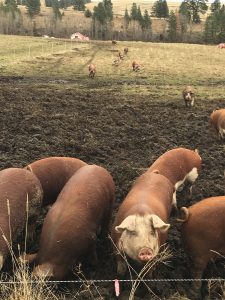Dave Flynn and Cory Carman own and manage one of the wonderful, productive and beautiful grass-based cattle operations in the Pacific Northwest. The fourth-generation, 2,500+ acre Carman Ranch in Wallowa, Oregon is just over the ridge from where I live, near Troy, Oregon.
We have bought our beef for years from the Carman Ranch, and more recently all our pork. Dave and Cory decided to diversify their meat production because of strong demand for heritage, pasture-raised pork among their beef clients and shoppers at the Portland farmers market.
As they gained experience with the pigs, Dave realized that integrating pasture-raised pork into a grass-fed beef ranch covering several thousand acres of rough, hillside land can do far more than produce a supply of quality meat – it also opens up new management options for improving Soil Health and capturing carbon.
Dave is now managing 18 Hereford-Tamsworth cross sows. They farrow about three times every 16 months, producing about 500 market hogs per year. Their hanging weight at slaughter is about 400 pounds, with a dressed weight of around 225 pounds.
The average hanging weight of a grass-fed steer raised at Carman Ranch is about 900 pounds, so a little over two finished hogs weigh about the same as a finished steer. Dave is moving toward marketing the hogs at around 200 pounds hanging, while their target for grass-fed beef is about 600 pounds hanging, so roughly three hogs will equal the production of one, finished beef animal.
The ranch sells its pasture pork to direct customers for around $3.00/pound. Its beef brings about $5.00/pound when sold per side or quarter, but more on average per pound when sold as specific cuts in smaller volumes. But taking the hanging weight size and price differences into account, five market hogs produce roughly the same gross income as one finished, grass-fed steer.
Slaughter hogs take about nine months from birth to slaughter, while grass-fed cattle take 24-26 months.
The hogs live off pasture year round, supplemented with free-choice grain, mostly locally grown wheat and barley, and mineral supplements. The sows consume roughly 6 pounds of grain/day, the feeder pigs eat all they want via mobile feeders placed out in the pasture fields.
The hogs spend all year outside, with just a few simple enclosures during the winter spread out over the winter pasture fields. The animals are moved and controlled with single-strand electric fence, which is affordable, easy to move, and highly effective. Dave feels that the booming pasture-pork industry would be impossible without today’s high-quality, electric fence technology. In fact, he told me, “Pigs would never have been put in confinement if this fencing technology had been available before. Pigs love it outside.”
Soil Health Machines

But the great surprise on Carman Ranch as its hog production increased, was what the pigs have done, and are doing right now to the often rough, rocky pastures they are raised on. They are, in short, largely self-feeding, near-maintenance-free soil health machines.
They spend their days uprooting shallow-rooted annual weeds like medusa head, cheatgrass, and rye (see pictures). Their aggressive burrowing to get every last root opens up the soil, reduces compaction, and with the benefit of hog manure, increases organic matter content. And they do it around the rocks, throughout the long days of summer.
The weeds removed by the pigs are not just converted to meat, their absence lessens competition for deep-rooted perennials like alfalfa. In the spring, Dave broadcast seeds fall wheat and alfalfa behind the pigs, just rolling it with a drum to improve seed-soil contact. The stand will then be grazed in the fall by the cattle and pigs, in various rotations. Sometimes a hay crop is taken off as well.
The ground is seeded a second time the next spring, usually after a light tillage, with a grass-alfalfa mix. Early growth is grazed in the fall, and then the field is managed as hay ground and/or pasture for the grass-fed beef and the mother cows. After a few to several years, the weeds come back and so its time to bring the pigs back to work their magic.
Parts of Carman Ranch have now been through two cycles of hog-delivered soil health. The results are amazing. Soil organic matter jumps from less than 2%, with some rough fields barely exceeding 1%, to 4% or even as high as 6%. These huge gains have sequestered thousands of tons of carbon in the soil, where it does all sorts of good things for the ranch, for water quality, for the animals raised on the ranch and the wild ones who live there.
Carman Ranch is one of thousands across the country that are pioneering innovative solutions to reverse the decline in the health of America’s farm and ranchland soils. This is a mission-critical task for the health of the nation.
Dave and Cory are already impressed with what the pigs can do, but are even more excited about what lies ahead. They understand that it takes a generation, and sometimes a few, to deeply understand how best to raise animals on a piece of land in ways that support a family, produce healthy food, and leave the land in better shape than the year before. I wish them, and the pigs, the best of luck in progressing along the learning curve, for the benefit of us all.

